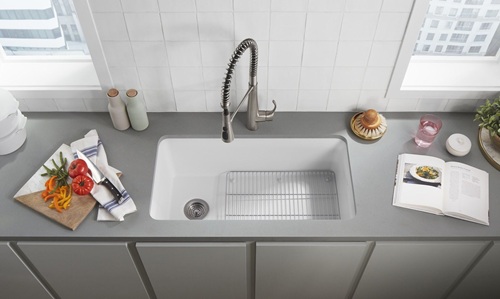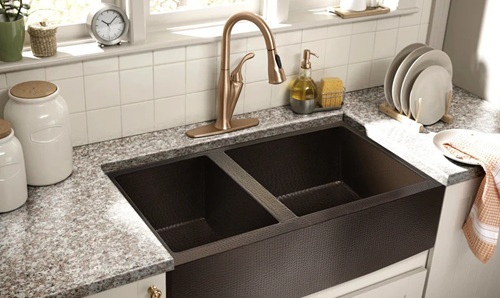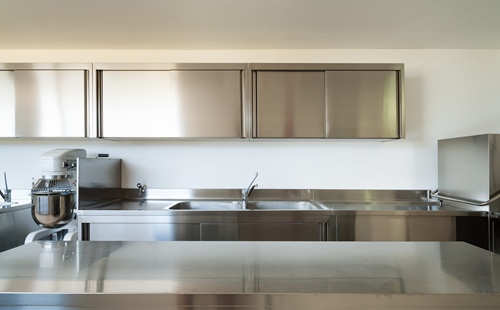When choosing a kitchen sink, most homeowners consider design, durability, and ease of maintenance. Among the many options available today, cast iron sinks stand out for their traditional charm, strength, and time-tested performance. Their glossy enamel coating, deep basins, and old-world appeal make them a favorite in both classic and farmhouse-style kitchens.
But like any material, cast iron sinks come with their own set of benefits and drawbacks. Lets break down the pros and cons of cast iron sinks, offering a detailed, practical guide to help you decide if this timeless fixture fits your modern kitchen needs.

🧱 What Is a Cast Iron Sink?
A cast iron sink is made from molded iron and coated with a layer of fused porcelain enamel. This enamel is fired at extremely high temperatures, resulting in a glossy, hard, and durable finish. Though these sinks have been around for over a century, they’re still widely used for their strength and style.
Available in a variety of colors, shapes, and configurations (single-bowl, double-bowl, apron-front, undermount, etc.), cast iron sinks are ideal for homeowners looking for a combination of beauty and longevity.
✅ Pros of Cast Iron Sinks
1. Timeless, Elegant Appearance
One of the biggest draws of cast iron sinks is their classic, glossy finish that complements both vintage and contemporary kitchens. Available in a range of colors (white being the most traditional), they reflect light beautifully, making kitchens look brighter and cleaner.
Style Tip: Pair a white cast iron farmhouse sink with butcher block or quartz countertops for a stunning rustic-modern blend.
2. Incredible Durability
Cast iron is incredibly strong. When coated with enamel, the sink becomes highly resistant to chipping, denting, and cracking. These sinks can last 25 to 50+ years with proper care — often outlasting other components of the kitchen.
Fact Check: Some antique cast iron sinks from the early 1900s are still in use today, proving their long-lasting nature.
3. Resistant to Stains and Discoloration
Thanks to the non-porous enamel coating, cast iron sinks are resistant to most stains. Food residues, sauces, and cleaning products don’t soak in, making them easy to clean with gentle soap and water.
Bonus: They’re less likely to show water spots compared to stainless steel sinks.
4. Heat and Scratch Resistant
You can place hot pots and pans directly in the sink without fear of melting or warping. The enamel surface is resistant to scratches from cutlery, cookware, and daily cleaning tools (though abrasives should still be avoided).
5. Sound Dampening Properties
Due to their solid, heavy build, cast iron sinks naturally absorb sound, making them quieter than lightweight alternatives like stainless steel. You’ll hear less noise from clanging dishes or running water.
6. Eco-Friendly Material
Cast iron is recyclable, and many manufacturers use recycled materials in the construction of these sinks. Plus, their long lifespan means less frequent replacement and reduced environmental waste.
❌ Cons of Cast Iron Sinks
1. Extremely Heavy
Cast iron sinks are much heavier than stainless steel or composite sinks. A typical cast iron sink can weigh 80–120 pounds or more, requiring extra structural support in cabinets and professional installation.
Pro Tip: Make sure your countertop and base cabinet are reinforced before installing one.
2. Vulnerable to Enamel Chipping
While the enamel is hard and glossy, it can chip or crack if you drop a heavy pan or hard object in the sink. Once chipped, the exposed iron may rust over time and require refinishing or touch-up kits.
Note: Avoid using cast iron or metal pans roughly in the sink to preserve the coating.
3. Limited Customization
Unlike stainless steel or composite sinks, which come in ultra-modern designs and slim profiles, cast iron sinks generally come in traditional shapes and sizes. If you’re aiming for a sleek, minimalist look, this material may not align with your style.
4. Color Fading or Crazing Over Time
With extended use and harsh cleaners, some enamel coatings may lose their shine, develop a “crazed” (cracked) appearance, or fade — especially in colored models. This can affect the visual appeal, though functionality typically remains intact.
Maintenance Tip: Use non-abrasive cleaners and avoid bleach to maintain color and finish.
5. Higher Upfront Cost
Compared to basic stainless steel or acrylic sinks, cast iron sinks are more expensive upfront — especially if you’re choosing an apron-front or designer model. Factor in the added cost of installation and structural reinforcement as well.
Price Range (USA): $400–$1,200+ depending on size and brand
⚖️ Cast Iron Sinks vs Other Sink Materials
| Feature | Cast Iron | Stainless Steel | Granite Composite | Fireclay |
| Appearance | Glossy, vintage | Sleek, modern | Matte, stone-like | Farmhouse, rustic |
| Durability | Excellent | Very Good | Excellent | Good |
| Heat Resistance | Excellent | Excellent | Very Good | Good |
| Scratch Resistance | Good | Fair | Excellent | Good |
| Stain Resistance | Excellent | Moderate | Excellent | Excellent |
| Weight | Very Heavy | Lightweight | Heavy | Heavy |
| Maintenance | Moderate | Easy | Easy | Moderate |
| Price | Moderate–High | Low–Moderate | Moderate | Moderate–High |
🛠️ Tips for Maintaining Cast Iron Sinks
- Avoid Abrasive Cleaners – Use a soft sponge and mild detergent. Avoid scouring pads or harsh chemicals like bleach.
- Dry After Use – Prevent mineral deposits and water spots by wiping the sink dry after use.
- Use a Protective Grid – Place a sink grid at the bottom to prevent cookware from chipping the enamel.
- Touch-Up Chips – Use enamel repair kits to touch up minor chips before they rust.
🏁 Final Verdict: Is a Cast Iron Sink Right for You?
✅ Choose a Cast Iron Sink If:
- You love classic, farmhouse, or vintage kitchen styles.
- You want a long-lasting, high-quality sink that can handle heat and heavy use.
- You appreciate a quieter sink with high stain resistance.
- You’re ready to invest in professional installation and structural support.
❌ Avoid a Cast Iron Sink If:
- You’re doing a budget or DIY remodel.
- You prefer a lightweight or ultra-modern design.
- You use your sink for frequent heavy-duty cleaning with tough objects.
- You’re not prepared for occasional enamel maintenance.
Conclusion
Cast iron sinks blend form and function with unmatched grace. They’re strong, stylish, and practical — the kind of feature that makes a statement and serves you reliably for decades. While they demand some care and come at a higher cost, the return is a durable, timeless addition to your kitchen that’s hard to beat.
If you’re building or renovating a kitchen that values both tradition and performance, a cast iron sink might just be the perfect centerpiece.

